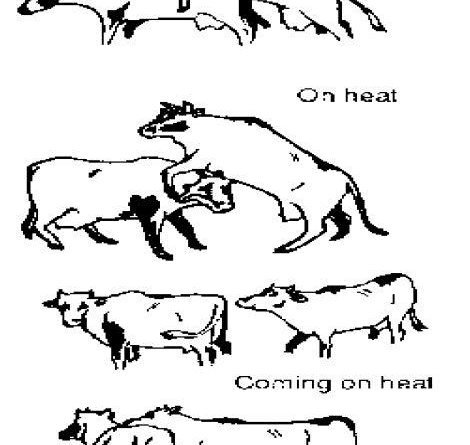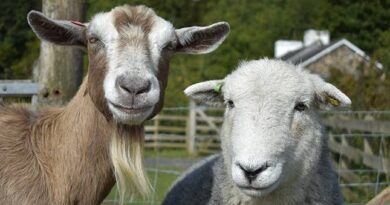The Age when Different Ruminant Animals get to Heat
Heat or oestrus in ruminant animals is the period when the female will accept the male and mate. There are signs which mark oestrus in all ruminants. Recognizing when the female is on heat means you will know when to put her with the male or use artificial insemination.
The age ruminant animals come to heat largely depends on their management. However, goat and sheep are supposed to come on heat normally after six months while cow should do same after a year.
It is usually good to mate them during the second heat because by then, they would have developed both physically and sexually. Feeding is a very important factor in determining when they will come on heat.
Therefore in order for them to reach sexual maturity on time, you as a ruminant farmer must make sure that your ruminant animals are well fed.
What is Heat in Ruminant Animals?
- The female reproductive system consists of two ovaries and a womb.
- Every so often the ovaries produce very small eggs (ova).
- The time when this happens is called heat or oestrus.
- Cattle and buffalo regularly come into heat all year round.
- Most sheep and goats come into heat at a particular time of the year (breeding season).
Knowing when an animal is in Heat
- If you know when an animal is in heat you can introduce her to a chosen male for mating or you can arrange for her to be artificially inseminated if the service is available.
- You will also be able to identify animals which do not go in heat.
- The best time to look for signs that the female is in heat is early morning or in the evening.
- Take care not to disturb the animals but just watch the animals for the signs.
Signs of Heat
- Ruminant animals can be kept on pasture or they may be stabled or tied up for most of the time.
- It is therefore necessary to consider this when looking for signs of heat:
Signs of Heat In Free Animals (At Pasture):
- Most females in heat will allow other animals to mount them.
- Cows in heat will mount one another, from the rear or from the front. However, the cow on top may not be on heat.
- The vulva becomes swollen and the area around the tail becomes wet and dirty.
- If cows sniff each other’s’ vulva and urine they may both come into heat.
- Cows can be coming into heat if they stand resting the chin on the back of another or are seen to lick or gently butt each other.
- Restlessness and calling loudly can also mean the female is coming into heat. Goats in particular become very noisy.
Read Also: Steps to Combat Heat Stress in Poultry Birds
Signs of Heats in Free Animals (At Pasture)

Signs of Heat in the stabled or tied animal;
The ruminant animals should be allowed out twice a day when they can be watched for signs of heat. If the female is not allowed out then the following will show that she is in heat:
- Swollen vulva.
- The animal is active, there is a loss of appetite and she calls loudly.
- In milking animals the amount of milk produced suddenly drops.
- A jelly-like mucous can be found on the floor with the dung.
You will need to be able to recognize the differences between signs of heat and signs of ill health in the animal which is tied up.
When do animals come into Heat for the first time?
- Animals come into heat when they reach puberty. This occurs at different ages in the different ruminants:
- Well-fed cows and buffalo come into first heat at 10 – 20 months of age.
- Sheep and goats come into first heat between 6 – 12 months of age.
How long does Heat last?
- The duration of heat is very short.
- In cows and buffalo, it lasts for less than a day.
- In goat’s heat lasts for 1 – 3 days.
- In sheep heat lasts for 1 – 2 days.
A healthy animal which was not mounted by a male or given artificial insemination will come back into heat. Cattle and buffalo cows will come into heat after 3 weeks, give or take a day or two), and female goats and sheep will come back into heat after 17 days, give or take a day or two.
Reasons for female not showing signs of Heat
- The female may not show signs of heat because she is too old, or she may have been mated without the owner knowing.
- Sometimes animals come into heat without showing any signs. This is called a “silent heat” and is common in buffalo cows.
- If the feed is not sufficient or there is a lack of protein, salts or water, the animal can fail to come into heat. You will need to improve the female’s feed to bring it into heat.
Anoestrus and Suboestrus – Clinical Signs
- Animals not showing regular signs of heat, repeat breeding and early embryonic mortality.
- At times heat signs, not visible properly.
- Reason – Nutritional deficiencies, management disorders, hormonal deficiency and uterine disorders.
Indigenous Treatments For Anoestrus
Anainerunji (Pedalium murex) 500gm is washed in 1000 ml of fermented rice water which will give an oily exudate. This is to be given orally for three days before the onset of estrous cycle. The animal may be inseminated when clear vaginal discharge is noticed. Or
Rhizomes of Ashwagandha (Withania somnifera) 150gm, gingelly seeds 150 gm are to be pounded well and mixed with poultry eggs (2 numbers) and 2 fruits of bananas(preferably Poovam variety of bananas) to make a semisolid preparation and give it for 7 days. If does not come into heat repeat the same treatment at 7 days’ interval (for 1 day only).
Read Also: Artificial insemination and Heat Detection in Pigs
Treatments For Suboestrus
Bengal gram (Cicer arietinum) 250 gm is soaked in water for 12 hours and tied in a cloth for 24 hours for sprouting and to be given the next day morning. This is to be repeated once in two days until the animal comes to heat.
Before giving this Sotrukatralai (Aloe vera) pulp from three sheaths after removing the spines in the sheaths is to be given for seven days. Before insemination 100 ml of neem oil has to be administered orally. Then after insemination feed 2 handful of Curry leaves (Murraya koenigii) for 10 days after insemination.
Read Also: The Effect of Heat Stress on Animal Productivity
Fertility of Heifers Mated as Yearlings
Low pregnancy rates and poor calving percentages in mobs of heifers mated as yearlings are usually associated with inadequate live weight at mating as live weight is the most important factor determining the onset of oestrus.
Pregnancy rates of more than 85% can be regularly achieved with yearling heifers that have reached critical weight before mating.
Calving Difficulty
Calving difficulty was commonly believed to result from mating heifers at too young an age. However, calving difficulty is now known to be a problem of first-calf heifers, whether they calve first at two years or three years.
Well-grown mated yearlings should have no more difficulty calving than heifers joined first as two-year-old’s, despite the more mature frame of three-year-old heifers.
This is because calf size increases with the increased frame of the dam, and older heifers tend be fatter at calving, both of which can lead to calving difficulty.
Growth of Heifers Mated as Yearlings
Provided nutrition is managed to ensure consistent good growth rates are achieved from weaning to calving, heifers joined as yearlings will achieve very similar mature weights as those joined later.
Target growth rates will vary with breed, genetics and weaning weight however in general ~0.7kg /day from weaning to calving is suitable. In addition, if nutrition and parasite control is carefully managed post calving any differences in mature weight are further reduced.
Fertility After First Calving
Heifers, particularly those calving at two years, take considerably longer after their first calving to return to heat. In many cases, heifers may become pregnant late or fail to conceive altogether.
This can be overcome by ensuring that only well grown heifers are mated, that the heifers calve down in good body condition, (condition score 3), and are well fed after calving to be joined at minimum of condition score 2.5.
Joining heifers a month earlier than the main herd is a management option that enables the heifers more time after calving to begin cycling before the start of mating.
Milk Production and Calf Growth
Young cows calving at two years produce less milk and wean lighter calves than older cows, but can still produce good calves if calved in good body condition and are well fed after calving.
Although the calves of yearling joined heifers are lighter at weaning, the following calves are as heavy as if the heifers had calved at three years.
The first calf of yearling joined heifers, although lighter, therefore represent an extra year of production and genetic gain, as opposed to heifers calving at three years of age.
Read Also: Why some Cows don’t expel their placenta after delivery and How to help them
Read Also: Waste to Energy Business: What You Need to Know









